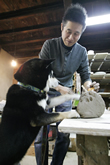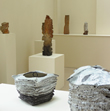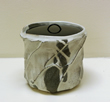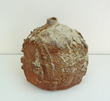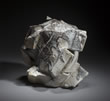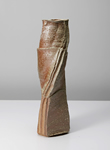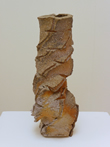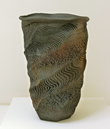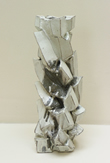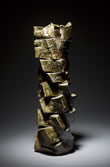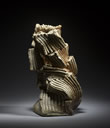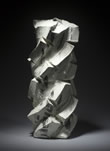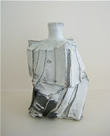SHOZO MICHIKAWA
Nature into Art
8 July - 5 August 2009

Download the pdf of our Shozo Michikawa catalogue (1MB)
Shozo Michikawa creates pots that have that rare quality of being imbued with both spirit and palpable energy. His work has been described as being like a ‘haiku in clay’, a simile that captures a sense not only of the apparent simplicity, but also the complexity of his work. His pots are intriguing because they are replete with contradictions: they have a contemporary feel, yet are somehow timeless; they have an almost impractically sculptural appearance, yet serve functional purposes; they reflect an urban aesthetic, but simultaneously look as if they have grown from nature. While many great thinkers have tried to quantify that elusive Japanese aesthetic of ‘Wabi Sabi’, to my Western untutored eye a tea bowl or kohiki incense burner by Shozo seems to be a modern manifestation of its qualities. His ceramics may, or may not, qualify under Soetsu Yanagi’s explanation that Wabi Sabi celebrates “the mellow beauty that time and care impart to materials,” (after all, Shozo has been nicknamed ‘Hurry Potter’ for his impressive throwing speed) but they do capture those intense emotions that are so hard to quantify.
When travelling in Japan last November, I had the great pleasure of being Shozo’s guest at his home in Seto, a city that is known as one of the ‘Six Old Kilns of Japan’, with a history of over 1300 years as a pottery centre. A lesser potter might feel oppressed by the weight of such a tradition, but although Shozo has an acute awareness and respect for the ceramic heritage of Japan, he has forged his own highly distinctive style and technique that makes his work stand out, not only from his contemporaries, but the great potters of the past. Significantly, he was the first Japanese artist to be honoured with a solo exhibition in the Forbidden City in Beijing in 2005. Shozo himself is not a native of Seto, but moved there precisely because of its heritage. He was born in Toya in Hokkaido in the North of Japan in 1953 and originally studied economics at Aoyama Gakuin University in Tokyo, where he worked in business for a couple of years, but discovered a natural affinity for pottery when he began evening classes. In the late 1970s, he took the brave step of giving up his life as a Tokyo businessman to become a potter. Perhaps this background, which is so different from many of his Seto neighbours who come from generations of potters, has brought a different urge to his creativity. Watching him at work was an exciting experience that shattered any preconceptions I might have had about how his pots were created.
At first glance, one would imagine that Shozo’s dramatic faceted and twisted forms are hand-built and sculpted but, in fact, the vases he was working on during my visit were created on the wheel. However, he does not ‘throw’ his vessels in any conventional sense; rather their energy comes from the twisting of fractured planes on an internal axis. It is a different understanding of his materials, to do with cutting and paring down, rather than expanding from a ball of clay. He speaks of having a ‘conversation with the clay’ and ‘assisting the way it wants to go,’ which reflects his profound respect for its natural qualities. An early morning walk through the woods with his Japanese husky dog revealed just as much about his attitude to nature: almost an animist veneration for natural forces such as rocks, trees and the very earth from which the clay is mined, a sensibility that finds expression in the natural intentions of his beautiful pots.
Simon Martin
Simon Martin in an art historian, writer and curator, based at Pallant House Gallery, Chichester.

